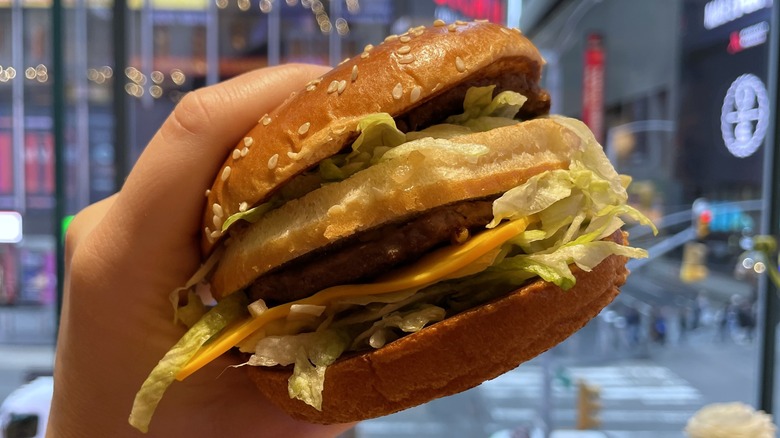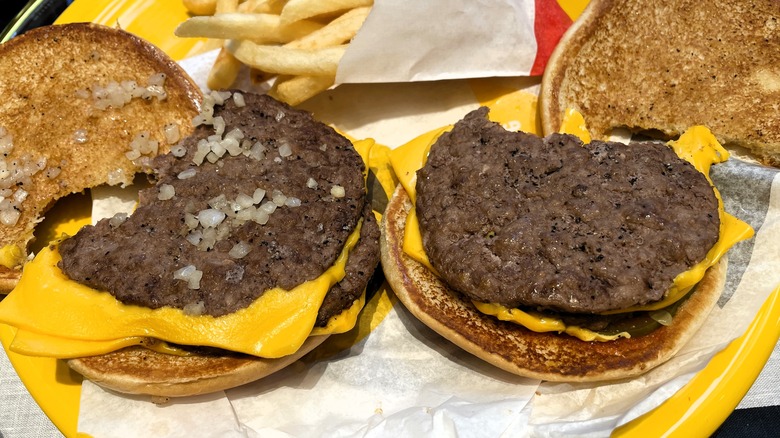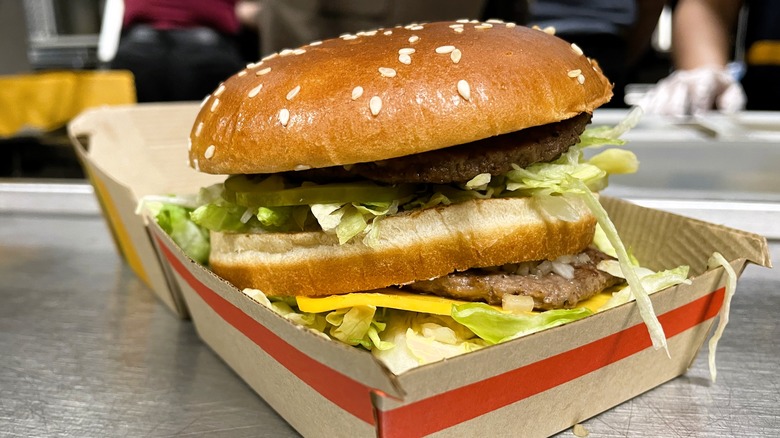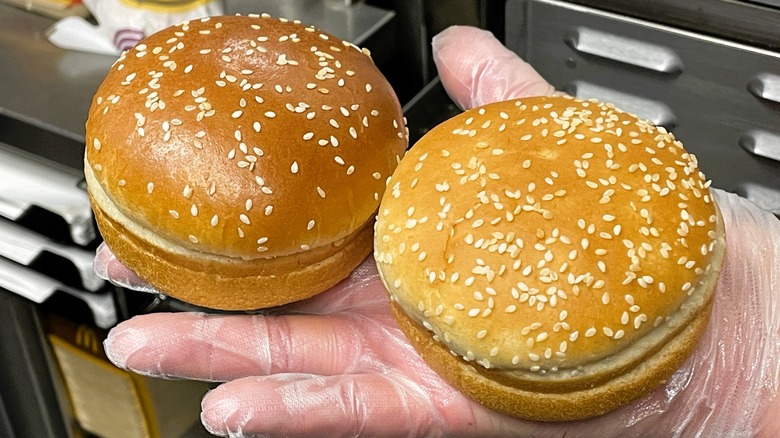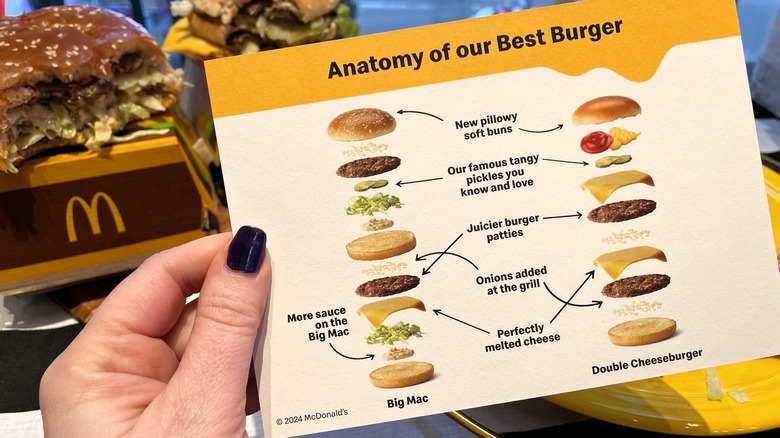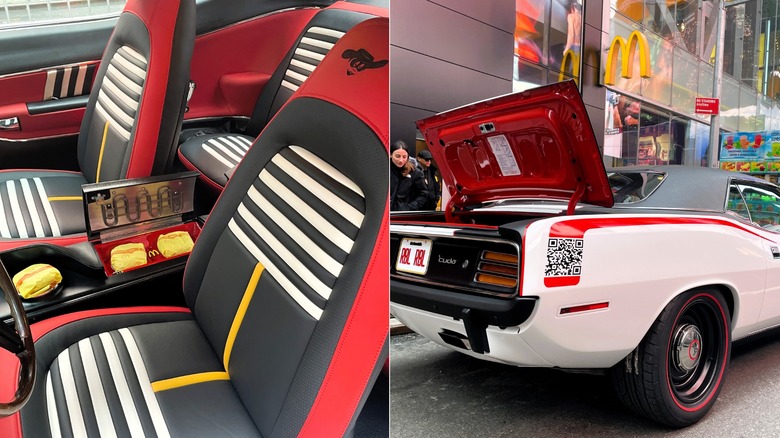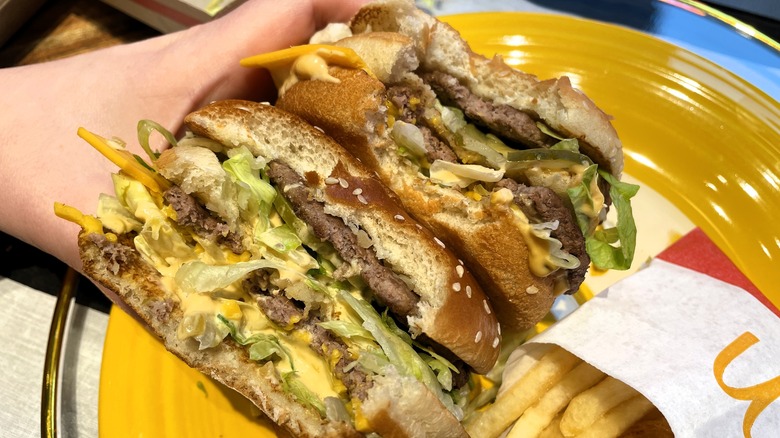McDonald's Is Raising Its Burger Game And We Have All The Juicy Details
It's been almost a year since McDonald's began rolling out changes to its core lineup of burgers, beginning in select markets across the country, and they are finally available in restaurants nationwide. But you won't see one or two giant changes to the burgers — instead, the upgrades to the burgers come as a result of about 50 much smaller changes that have been made to the cooking techniques and assembly of the McDonald's burgers that you already know and love. Why mess with success? Even though McDonald's dominates the fast food market, the company knows that to stay on top, it has to be competitive — and to be competitive, it has to pay attention to what customers want to see and eat.
In response to that feedback, McDonald's has created the Best Burger. Contrary to how it might sound, the Best Burger isn't a singular new offering, but a series of upgrades to the existing McDonald's burger lineup. In fact, some of the changes seem so subtle that the casual burger observer might not even notice the changes. So, to highlight the changes, McDonald's invited Mashed to its Times Square restaurant location in NYC to see firsthand how the Best Burgers are prepared, and to taste the new burger preparation side-by-side with the old method. You might be wondering if the burgers are noticeably different, or if they still taste like McDonald's burgers after so many improvements. So we've got all the juicy details on the new changes, and how all these improvements will affect your favorite McDonald's burger.
Changes to the burger's cooking technique
The vast majority of the changes to McDonald's burgers don't involve any actual ingredient changes, but instead, many small changes to the cooking techniques and assembly of the burgers. During the tasting of newly redesigned burgers, we were invited into the noticeably efficient McDonald's kitchen to see exactly how the burgers are prepared, beginning with cooking the burger patties. McDonald's uses a two-sided grill (also called a platen grill), which cooks the patties on both the top and the bottom at the same time.
Until now, eight burgers were cooked at once on a single-platen grill, but by reducing the number of burgers cooked at one time to six, several key changes occur. Fewer burgers on the grill allow for more airflow around the patties, resulting in burgers that cook faster, retain more moisture, and subsequently hold on to more flavor.
The final change of the cooking process comes immediately after the patties are finished cooking. Each of the six patties gets a hit of burger seasoning (which hasn't changed) before finely chopped onions are added to the patties on the grill to finish cooking. The addition of onions during the cooking process, instead of during assembly, helps to slightly soften and caramelize the onions, during which time the onions also absorb some of the burger's juices and amp up the grilled flavor of the burger as a whole.
Changes to the burger assembly process
After the patties are finished cooking, the assembly process begins with a few key changes. First, the American cheese slices that get added to your burger are more tempered than they were before, which really just means that cold cheese doesn't go straight from the refrigerator to the top of your hot burger patty. Instead, the cheese is allowed to come to room temperature before going onto the sandwich, which helps the slices melt a little better and keeps your burger nice and hot in the process.
On the Big Mac, you'll find even more Mac sauce than before, now with two very generous squirts added to the sandwich. The way the lettuce on the Big Mac is handled has also seen a slight improvement. In order to keep the lettuce on the sandwich crisp, less of the lettuce is stored on the open assembly line. Because less lettuce is on the assembly line, it has to be refilled more often from the refrigerator, leaving less time for the lettuce to go soft between the chilly refrigerator and your burger. Given how much lettuce is stuffed into a Big Mac, it's a small change with pretty big ramifications — because no one likes a sandwich with limp lettuce.
Additionally, for those who happened to like the bite of raw onions added during the assembly process, you can still ask for onions to be added to your burger after cooking. You're still getting two pickles and all of the other condiments that typically come with your burger of choice.
The new Best Burger buns
The only part of the Best Burgers changeover that's seeing an actual ingredient change is the burger buns, and in a side-by-side comparison, it's clear that the buns have been adjusted. Both the regular buns and the Big Mac buns have a shinier finish and a slightly deeper golden color. McDonald's claims that the newer buns are more "pillowy soft" than they were before, and they certainly appear to be fluffier, with a noticeable amount of height and springiness.
During assembly, the buns first make their way through a rolling conveyor for a very light toasting. This helps keep the buns from getting soggy with the addition of sauces and juices from the burger patty. Then each of the buns is laid out on the counter (or built directly in the burger box, in the case of the Big Mac), and assembled to order.
A quick comparison of the ingredients list of the current Big Mac buns, and for the buns in 2013 shows just how far the buns have come. The main ingredients are still the same, including enriched flour, water, sugar, yeast, and soybean oil. But the lesser ingredients include fewer stabilizers, preservatives, and dough conditioners than before. While the newer buns were designed to be more appealing, there are some who aren't totally sold on the upgrade. There's even a petition on Change.org for McDonald's to bring back the last buns.
Which burgers are getting the Best Burger treatment?
The majority of the burgers on McDonald's menu are getting the Best Burger upgrade, including the Big Macs, and all of the original McDonald's burgers. The original burgers include the Hamburger, Cheeseburger, Double Cheeseburger, and the McDouble (which is the same as a double cheeseburger, only with a single slice of cheese instead of two). For a limited time, McDonald's is also offering the fan-favorite Double Mac, which is a regular Big Mac, but with four burger patties instead of two.
You might have noticed that the Quarter Pounder and Double Quarter Pounder burger options aren't included in the new burger design rollout. The last time the Quarter Pounder sandwiches saw an upgrade was when McDonald's switched the patties over to 100% pure North American beef in 2018. Because of the change, the company saw more than 40,000 more quarter-pound burgers sold from the beginning of 2018 through the beginning of 2019.
But that doesn't mean that your Quarter Pounder won't see some of the improvements from the technique changes anyway. It's likely that you'll still get the same tempered American cheese slices on your Quarter Pounder, and if you order it with additional lettuce, you'll also benefit from the new assembly system. But for the time being, all of the Quarter Pounder sandwiches are still made with the same Quarter Pounder bun, and the included onions are added during the assembly process.
What's that sneaky Hamburgler up to now?
McDonald's has been finding ways to bring its old-school cast of characters out of the vault, by reintroducing them to the now grown-up audience that once enjoyed them as kids. Last summer, the berry-flavored Grimace shake was released to celebrate the McDonaldland creature's birthday, and sparked a viral TikTok trend for those with a dark sense of humor. A new line of McNugget Buddies toys was also released in 2023 as part of the Kerwin Frost Box — a grown-up Happy Meal with a strong hit of nostalgia.
The release of the Best Burgers has attracted the attention of another one of McDonald's classic characters, the infamous burger-coveting Hamburglar. But now, apparently, the Hamburglar is old enough to have a driver's license and is taking his custom-designed 1970 Plymouth Barracuda on a coast-to-coast drive to abscond with as many of the upgraded burgers as he can. If you happen to see his "Burgercouda" on the road, you should stop to check it out — if only to see the custom burger warmer built into the center console. But you can also scan the QR code on the back of the car for first dibs on Hamburgler-themed swag and a McDonald's gift card to go try the new Best Burgers for yourself. Even if you don't catch the Hamburglar in action, you can still go to spothamburglar.com for a chance to win free burgers for a year, which is a steal all on its own.
Final Verdict: Best is absolutely better
To fully grasp the new changes, McDonald's presented us with side-by-side tastes of both the new and previous burger preparations, for both the Double Cheeseburger and Big Mac burgers. The visual difference between the buns is clear in both formats, making for taller buns that don't flatten quite as easily as their predecessors. The flavors of the buns are similar, so it's not an intimidating change for anyone who might have been especially partial to the previous buns.
Even before biting into the Best Burgers, it was clear that the patties were juicier because the sandwiches prepared with the new cooking method were noticeably heavier. The newer burgers were also warmer to the touch and seemed more substantial when I finally took a bite. I preferred the taste of the grilled onions on the burgers over the flavor of the biting raw onions used in the previous iteration because the cooked onions seemed to better blend into the flavor of the burgers as a whole. The most noticeable difference, to me, was the additional Mac sauce on the new version of the Big Mac. Given how much lettuce is on the burger, having that additional sauce made the whole package feel juicier, saucier, and more enjoyable all around.
Ultimately, all of the small changes that have gone into creating the Best Burgers have certainly made for an improved burger experience, and I'd gladly take the newer preparation over the last one every time.
Static Media owns and operates Mashed and Tasting Table.
